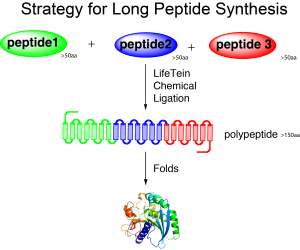
Long peptide synthesis by click chemistry

Long peptide synthesis by click chemistry
Post-translational modifications (PTMs) of histone proteins, such as acetylation, methylation, and phosphorylation, are pivotal in regulating chromatin dynamics. Among these, the role of methylation, particularly at arginine or lysine residues, stands out for its complexity and significance. LifeTein, a leader in peptide synthesis, has contributed significantly to this field by synthesizing mono-, di-, or tri-methylated peptides. These peptides are instrumental in studying protein-protein interactions, especially in the context of histone methylation.
Histone methylation, a process that can signal either transcriptional repression or activation, is increasingly recognized for its interrelation with DNA methylation in mammals. For instance, the targeting of DNA methylation is intricately linked to H3K9 methylation, a key regulatory mechanism in gene expression. The p53 gene, known as the guardian of the genome and frequently mutated in human cancers, is regulated by various PTMs, including methylation.
LifeTein’s contribution to this research is highlighted in a study focusing on the ASHH2 CW domain, which is responsible for recognizing the methylation state at lysine 4 of histone 3 N-terminal tails. This domain is crucial in recruiting the ASHH2 methyltransferase enzyme to histones. The study utilized H3 histone tail mimicking peptides, specifically monomethylated (ARTK(me1)QTAR), dimethylated (ARTK(me2)QTAR), and trimethylated (ARTK(me3)QTAR) peptides, all synthesized by LifeTein with a remarkable 95% purity as confirmed by mass spectrometry.
The research documented the assignment of a shortened ASHH2 CW construct, CW42, which showed similar binding affinity and better expression yields than previous constructs. This advancement is significant in understanding how different methylation states affect protein-peptide interactions. The study also performed 1H–15N HSQC-monitored titrations to determine the saturation point of the protein-peptide complex. The findings revealed that the CW42 domain, when bound to the monomethylated histone tail mimic, showed similar perturbations in shifts as the di- and tri-methylated instances.
In summary, LifeTein’s synthetic methylated peptides have been instrumental in advancing our understanding of histone methylation. Their high-purity peptides have enabled researchers to delve deeper into the complexities of chromatin dynamics and gene regulation, paving the way for future discoveries in epigenetic therapies and cancer treatment.
Read the full article on SpringerLink](https://link.springer.com/article/10.1007/s12104-018-9811-x) for more detailed insights into this groundbreaking research.
Noble metal gold (Au) and silver (Ag) nanoparticle (NPs) are used to conjugate with M3 peptides. The AuNPs-sGFP andAuNPs-M3 peptide form SERS active hot spot through self-assembly and GFP complementation. The nanoparticles self-assemble into surface-enhanced Raman-scattering (SERS) nanoclusters. The nanocluster can be used as contrast agents for multimodal SERS and photoacoustic microscopy with single-cell sensitivity.
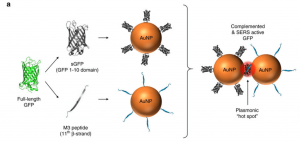
AuNPs coated with M3 peptides-GFP
Reference: M3 peptide was purchased from LifeTein.
https://www.nature.com/articles/s41467-018-03046-w
Our Services:
Custom Peptide Synthesis Services
Custom Chemical Synthesis Other Posts: How to generate highly stable D-amino acid analogs of bioactive helical peptides? A six-mer synthetic peptide (AT1002) showed enhanced nasal drug delivery A simple protocol: Maleimide labeling of peptide and other thiolated biomolecules
Using D-amino acids as the building blocks for bioactive peptides can dramatically increase their potency. In this study, the authors generated a database of ∼2.8 million D-peptides using a mirror image of every structure in the Protein Data Bank (PDB). The critical or hotspot residues were studied. Residues critical to target binding and activity can then be ideally done experimentally such as alanine scanning mutagenesis. It can also be carried out computationally such as thermodynamic integration or free energy perturbation.
Two peptides were tested to prove the concept: GLP-1 and Parathyroid Hormone. Both (L)- and (D)-peptides were synthesized by Lifetein LLC.
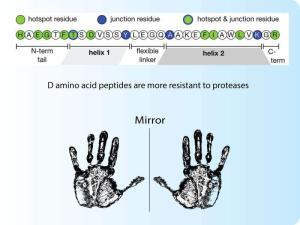
D amino acid peptides
Glucagon-Like Peptide 1, GLP – 1 (7 – 36), amide, human:
HAEGTFTSDVSSYLEGQAAKEFIAWLVKGR – NH2
2. Parathyroid Hormone (PTH) is an FDA-approved treatment for osteoporosis. The (D)-PTH activates PTH1R with a potency and efficacy comparable to (L)-PTH. And more than 85% of the (D)-PTH analog is still detectable at six hours.
PTH 1-34: SVSEIQLMHNLGKHLNSMERVEWLRKKLQDVHNF
Conclusion: The D-Protein Data Bank (PDB) can be used to search and find therapeutically active topologies. The D-PDB could be a key tool for finding stable lead molecules in early-stage drug discovery.
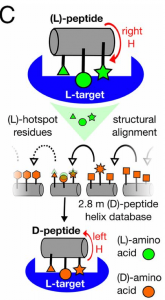
Hot spot residues for receptor binding
Reference:
Our Services:
Custom Peptide Synthesis Services
Other Posts:
Noble metal gold and silver nanoparticle are conjugated with peptides for cellular imaging
A six-mer synthetic peptide (AT1002) showed enhanced nasal drug delivery
A simple protocol: Maleimide labeling of peptide and other thiolated biomolecules
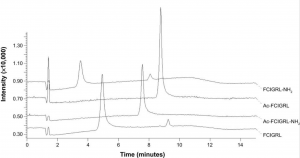
Peptide amidation
Order your Gene Synthesis Service at a competitive price! Now it is 30% off. Email us at gene@lifetein.com for a quote.
Order now: https://www.lifetein.com/protein-expression-service.html

Oligo-peptide conjugation
Our Services:
Custom Peptide Synthesis Services
Other Posts:
Monitoring T cell–dendritic cell interactions in vivo using labeled peptides